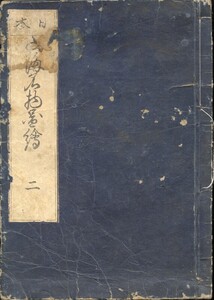Illutrated guide of specialties of the mountains and seas of Japan
日本山海名物圖繪
Nihon sankai meibutsu zue
This illustrated guide was written by Hirase Tessai 平瀬徹齋 and illustrated by Hasegawa Mitsunobu 長谷川光信. It was published in Ōsaka in one volume in 1754 and reedited in five volumes in 1797. It was followed in 1799 by another 5-volume book with almost the same title, Nihon sankai meisan zue 日本山海名産圖繪 (Illustrated guide of famous productions of the mountains and seas of Japan), with an unidentified author and a different illustrator (Shitomi Kangetsu). The two titles only differ by one character and the books have much in common, they can be considered as a diptych. They were both published by a family of book publishers, the Hirase, under the bookseller's name Chigusaya Shin'emon 千草屋新右衛門. The two guides were published during a period of intense activity on the part of Ōsaka booksellers to promote famous sites of their region : Izumi meisho zue 和泉名所圖繪 (1796), Settsu meisho zue 摂津名所圖繪 (1796-98), Kawachi meisho zue 河内名所圖繪 (1801), following the success of illustrated guides of Ise shrine and Kyoto1.
The two guides describe the main stages of manufacturing in rural areas, the historical origin, regional varieties, the qualities of the product as well as the classics and poems evoking the subject. According to the postface of Meibutsu zue, the illustrations were produced in situ, "by inquiring with people who, in the provinces, drew their resources from the exploitation of rivers, seas and mountains", and remunerating them accordingly, thus providing a faithful view of the described activity. Volume 1 of Meibutsu zue is dedicated to the process of extraction and refining of metals (gold, silver, copper, lead), while volume 1 of Meisan zue deals with the production of Itami saké. The other volumes cover more diverse subjects.
We present here volume 2 of Meibutsu zue. The text has been reproduced, but not translated, except for the title. Click on the cover to access the images.
日本 山海名物圖繪 二 |
 |
There are two red seals on the first page of the book, 春木文庫 (Haruki Bunko) and 伊勢春木 房光松圃 圖書之記. They indicate that it was formerly owned by the Haruki family, who was the head of the outer shrine (Geku) of Ise Grand Shrine.
The five volumes of the book are available at Kyushu University Library.
and at the Next digital Library
(Vol.1,
Vol.2,
Vol.3,
Vol.4,
Vol.5).
They are described in detail by mominaina on the media platform note.com
1. Much of this introduction was taken from Guide illustré des produits renommés des monts et mers du Japon edited by Annick Horiuchi.↩